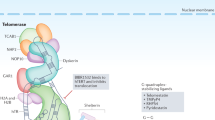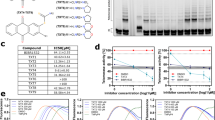Abstract
Human telomerase has been implicated in cell immortalization and cancer. Recent works suggest that telomerase confers additional function required for tumorigenesis that does not depend on its ability to maintain telomeres. This new action may influence tumor therapy outcomes by yet unraveled mechanisms. Here, we show that overexpression of the catalytic subunit of telomerase (hTERT) protects a maturation-resistant acute promyelocytic leukemia (APL) cell line from apoptosis induced by the tumor necrosis factor (TNF) or TNF-related apoptosis-inducing ligand (TRAIL) and not from apoptosis induced by chemotherapeutic drugs such as etoposide or cisplatin. Conversely, in these cells, TRAIL-induced cell death is magnified by all-trans retinoic acid (ATRA) treatment, independently of telomerase activity on telomeres. Of note, this response is subordinated neither to maturation nor to telomere shortening. This work underlines that retinoids and death receptor signaling cross-talks offer new perspectives for antitumor therapy.
This is a preview of subscription content, access via your institution
Access options
Subscribe to this journal
Receive 50 print issues and online access
$259.00 per year
only $5.18 per issue
Buy this article
- Purchase on Springer Link
- Instant access to full article PDF
Prices may be subject to local taxes which are calculated during checkout



Similar content being viewed by others
Abbreviations
- hTERT:
-
human telomerase reverse transcriptase
- ATRA:
-
all-trans retinoic acid
- GFP:
-
green fluorescent protein
- TNF:
-
tumor necrosis factor
- TRAIL:
-
TNF-related apoptosis-inducing ligand
- DR:
-
death receptor
- DAPI:
-
diamino-2-phenyl-indol
- APL:
-
acute promyelocytic leukemia
- TUNEL:
-
terminal deoxynucleotidyl transferase (TdT)-mediated dUTP nick-end labeling
- TRAP:
-
telomeric repeat amplification protocol
- TA:
-
telomerase activity
References
Aisner DL, Wright WE and Shay JW . (2002). Curr. Opin. Genet. Dev., 12, 80–85.
Ashkenazi A and Dixit VM . (1998). Science, 281, 1305–1308.
Duprez E, Ruchaud S, Houge G, Martin-Thouvenin V, Valensi F, Kastner P, Berger R and Lanotte M . (1992). Leukemia, 6, 1281–1287.
Folini M, De Marco C, Orlandi L, Daidone MG and Zaffaroni N . (2000). Eur. J. Cancer, 36, 2137–2145.
Fu W, Begley JG, Killen MW and Mattson MP . (1999). J. Biol. Chem., 274, 7264–7271.
Fu W, Killen M, Culmsee C, Dhar S, Pandita TK and Mattson MP . (2000). J. Mol. Neurosci., 14, 3–15.
Golstein P . (1997). Curr. Biol., 7, R750–R753.
Gorbunova V, Seluanov A and Pereira-Smith OM . (2002). J. Biol. Chem., 277, 38540–38549.
Green DR and Reed JC . (1998). Science, 281, 1309–1312.
Greider CW and Blackburn EH . (1985). Cell, 43, 405–413.
Hahn WC, Stewart SA, Brooks MW, York SG, Eaton E, Kurachi A, Beijersbergen RL, Knoll JH, Meyerson M and Weinberg RA . (1999). Nat. Med., 5, 1164–1170.
Helder MN, Wisman GB and van der Zee GJ . (2002). Cancer Invest., 20, 82–101.
Kondo Y, Kondo S, Tanaka Y, Haqqi T, Barna BP and Cowell JK . (1998). Oncogene, 16, 2243–2248.
Kushner DM, Paranjape JM, Bandyopadhyay B, Cramer H, Leaman DW, Kennedy AW, Silverman RH and Cowell JK . (2000). Gynecol. Oncol., 76, 183–192.
Lanotte M, Martin-Thouvenin V, Najman S, Balerini P, Valensi F and Berger R . (1991). Blood, 77, 1080–1086.
Lingner J and Cech TR . (1998). Curr. Opin. Genet. Dev., 8, 226–232.
Lu C, Fu W and Mattson MP . (2001). Brain. Res. Dev. Brain Res., 131, 167–171.
Ludwig A, Saretzki G, Holm PS, Tiemann F, Lorenz M, Emrich T, Harley CB and von Zglinicki T . (2001). Cancer Res., 61, 3053–3061.
Mergny JL, Riou JF, Mailliet P, Teulade-Fichou MP and Gilson E . (2002). Nucleic Acids Res., 30, 839–865.
Meyerson M, Counter CM, Eaton EN, Ellisen LW, Steiner P, Caddle SD, Ziaugra L, Beijersbergen RL, Davidoff MJ, Liu Q, Bacchetti S, Haber DA and Weinberg RA . (1997). Cell, 90, 785–795.
Morin GB . (1989). Cell, 59, 521–529.
Pan G, O'Rourke K, Chinnaiyan AM, Gentz R, Ebner R, Ni J and Dixit VM . (1997). Science, 276, 111–113.
Pendino F, Flexor M, Delhommeau F, Buet D, Lanotte M and Segal-Bendirdjian E . (2001). Proc. Natl. Acad. Sci. USA, 98, 6662–6667.
Pendino F, Sahraoui T, Lanotte M and Segal-Bendirdjian E . (2002). Leukemia, 16, 826–832.
Rubio MA, Kim SH and Campisi J . (2002). J. Biol. Chem, 277, 28609–28617.
Rubio MA, Davalos AR and Campisi J . (2004). Exp. Cell Res., in press.
Ruchaud S, Duprez E, Gendron MC, Houge G, Genieser HG, Jastorff B, Doskeland SO and Lanotte M . (1994). Proc. Natl. Acad. Sci. USA, 91, 8428–8432.
Schulze-Osthoff K, Ferrari D, Los M, Wesselborg S and Peter ME . (1998). Eur. J. Biochem., 254, 439–459.
Sheridan JP, Marsters SA, Pitti RM, Gurney A, Skubatch M, Baldwin D, Ramakrishnan L, Gray CL, Baker K, Wood WI, Goddard AD, Godowski P and Ashkenazi A . (1997). Science, 277, 818–821.
Smith LL, Coller HA and Roberts JM . (2003). Nat. Cell. Biol., 5, 474–479.
Stewart SA, Hahn WC, O'Connor BF, Banner EN, Lundberg AS, Modha P, Mizuno H, Brooks MW, Fleming M, Zimonjic DB, Popescu NC and Weinberg RA . (2002). Proc. Natl. Acad. Sci. USA, 99, 12606–12611.
Yuan Z and Mei HD . (2002). Hematol. J., 3, 201–205.
Acknowledgements
This work was supported by INSERM, the Ligue contre le Cancer, and Association pour la Recherche contre le Cancer (ARC nos. 4513 and 3416). FP and AS were funded by the Fondation pour la Recherche Médicale (FRM).
Author information
Authors and Affiliations
Corresponding author
Rights and permissions
About this article
Cite this article
Dudognon, C., Pendino, F., Hillion, J. et al. Death receptor signaling regulatory function for telomerase: hTERT abolishes TRAIL-induced apoptosis, independently of telomere maintenance. Oncogene 23, 7469–7474 (2004). https://doi.org/10.1038/sj.onc.1208029
Received:
Revised:
Accepted:
Published:
Issue Date:
DOI: https://doi.org/10.1038/sj.onc.1208029
Keywords
This article is cited by
-
Short-term inhibition of TERT induces telomere length-independent cell cycle arrest and apoptotic response in EBV-immortalized and transformed B cells
Cell Death & Disease (2016)
-
New prospects for targeting telomerase beyond the telomere
Nature Reviews Cancer (2016)
-
Telomerase reverse transcriptase inhibition stimulates cyclooxygenase 2 expression in cancer cells and synergizes with celecoxib to exert anti-cancer effects
British Journal of Cancer (2013)
-
Telomerase reverse transcriptase promotes epithelial–mesenchymal transition and stem cell-like traits in cancer cells
Oncogene (2013)
-
Telomerase prevents accelerated senescence in glucose-6-phosphate dehydrogenase (G6PD)-deficient human fibroblasts
Journal of Biomedical Science (2009)



